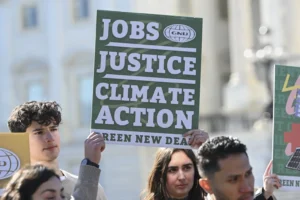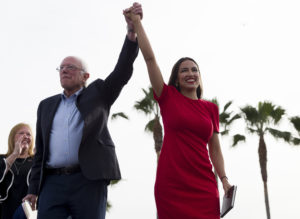The Green New Deal Could Eradicate Poverty
Support is growing for a plan to tackle climate change, our economic crisis and deepening social divisions all at once. DAVID SONLUNA / Unsplash
DAVID SONLUNA / Unsplash
If you haven’t yet heard of the Green New Deal, chances are that you soon will. To its growing band of supporters, it looks like an idea whose time has come.
Just suppose we could see a way to transform the global economy, society and even the environment so that they met real needs, and promised to go on doing so far into the future. Well, we can. And it’s growing simpler all the time, futurologists say.
The bad news? Inertia and resistance. Too few of us think we really need a transformation. Too many are actively trying to prevent one. No change there then − except that the balance may be starting to shift, thanks largely to science and money − and ordinary people who are refusing to go on as we are.
Supporters of the Green New Deal say we don’t have to look very far ahead for results − no further than about mid-century.
By then, some of them told The New Yorker magazine, much of the world should be able to achieve the goal of zero carbon emissions, a goal for which they say the world already has about 90-95% of the technology it needs.
Technological Gallop
One problem often raised is the need to store the power produced by wind and solar power, which may be inconveniently unavailable just when it’s needed. But even here there are hopeful signs that the galloping pace of technological advance may soon have an answer in the form of greatly improved batteries.
The Deal’s supporters are not the first to claim we’re most of the way towards a carbon-free future in 30 years, and possibly well before that. But this Deal, itself a reminder of US President Franklin D Roosevelt’s 1933 New Deal, explores more ambitious territory still, with the prospect of also ensuring a living wage job for everyone who wants one and reducing racial, regional and gender-based inequalities in income and wealth.
To make any headway the new Deal will need strong political backing. Here it’s had a stroke of luck, being identified with the arrival in Washington DC of the politician Alexandria Ocasio-Cortez, the youngest woman ever elected to the US Congress.
There are signs across the Atlantic of mounting involvement in the ideas spelt out in the Green New Deal, incorporating lessons learned from France, for instance, and the experience of Germany.
In Britain a rising star of the parliamentary opposition, Clive Lewis, the shadow sustainable economy minister, told a recent meeting: “The green economy will simply be ‘the economy’ under the next Labour government”.
The British economist Ann Pettifor, a fellow of the New Economics Foundation, describes the Green New Deal as “incredibly ambitious . . . a huge advance for green campaigners and, hopefully, for our threatened species.” Pettifor was co-author of the original Green New Deal Report, published in the UK in 2008, which in many ways prefigured the present US initiative.
Her fellow co-author was Andrew Simms, now co-ordinator of the Rapid Transition Alliance (RTA), an enthusiastic backer of Ocasio-Cortez’ vision.
The RTA says: “Like the UK proposal, [the Deal] seeks to tackle the climate and economic crisis simultaneously and looks at job creation, decarbonising electricity, renovating buildings for energy efficiency and much more.
Affordable
“A Green New Deal today would cost no more than [Roosevelt’s] New Deal, less than the 2008 bailouts, and see off the worst effects of the climate crisis.”
Simms told the Climate News Network: “What does it actually look like to start transforming our economies to prevent climate breakdown and meet the internationally agreed climate targets?
“Practically it looks like a Green New Deal − a programme that meets our economic, social and environmental needs at the same time − a ‘win, win, win’ package of measures.
“Any Green New Deal worthy of the name creates millions of ‘green collar’ jobs by building the low-carbon infrastructures which respect environmental limits and are vital to modern economies − renewable energy, zero carbon homes, efficient and clean mass transport systems delivered by switching investments from old, dirty ways of doing things and with innovative financial mechanisms. The opportunities are immediate, needed and everywhere.”
Obstacles Remain
Perhaps an idea which puts the environment, the economy and social justice together can hope to mobilise mass support in a way the three distinct groups have so far not managed to achieve − especially when it exploits the potential of new technology and falling costs. But there’s still political inertia to reckon with, and financial self-interest.
Even there, change may be afoot. A British group of scientists, activists and one former archbishop of Canterbury, ExtinctionRebellion, has been staging audacious public protests in the UK for four months now, and started a spring uprising on 16 March, giving no sign yet of succumbing to inertia.
And resistance to the very idea that the world needs an energy transformation? A brief online search for the way parts of the fossil fuel industry continue to challenge and decry climate science suggests change could be coming there too. One example from the US site Inside Climate News shows the deniers are facing challenges of their own.
Change on the scale envisaged by the Green New Deal is certainly demanding, but it will be far less so than refusing to change.
Your support is crucial...As we navigate an uncertain 2025, with a new administration questioning press freedoms, the risks are clear: our ability to report freely is under threat.
Your tax-deductible donation enables us to dig deeper, delivering fearless investigative reporting and analysis that exposes the reality beneath the headlines — without compromise.
Now is the time to take action. Stand with our courageous journalists. Donate today to protect a free press, uphold democracy and uncover the stories that need to be told.






You need to be a supporter to comment.
There are currently no responses to this article.
Be the first to respond.